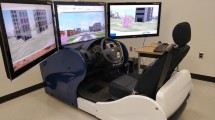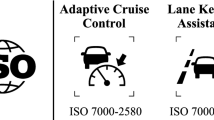Abstract
A study was carried out using simulation to investigate driver responses to lineside signals and signs at various approach speeds. The objectives of the study were: (1) to find out whether train speed would significantly affect signal/sign reading; (2) to examine at which point certain types of signs or signals could be detected or recognised, and (3) to determine a speed cut-off level above which certain types of signs or signals are no longer recognisable or detectable. Fifty-seven train drivers from 12 Train Operating Companies in the UK participated in the trials. Twenty different types of lineside signs and ten types of signals were tested under six different approach speeds ranging from 100 to 350 km/h (62–218 mph). Driver performance measures were ‘time remaining to the signal/sign’ at the point of detection or recognition, and reading error rate. The results showed a significant influence of train speed on driver responses to lineside signals/signs and demonstrated a non-linear relationship between driver responses to signals/signs and approach speed. This has been used to estimate a maximum approach speed limit within which a specific signal or sign can be correctly detected or recognised. The findings and implications of the study are discussed in the paper.







Similar content being viewed by others
References
Adelson EH, Movshon JA (1982) Phenomenal coherence of moving visual patterns. Nature 300:523–525
Allen RW, Parseghian Z, Rosenthal RJ (1994) Simulator evaluation of road signs and signals. In: Proceedings of the Human Factors and Ergonomics Society 38th Annual Meeting, Nashville, TN
Allen RW, Fancher PS, Levison WH, Machey J, Mourant RR, Schnell T, Srinivasan R (1999) Simulation and measurement of driver and vehicle performance TRB Publications, A3B06. Transportation Research Board, Washington, DC
Bhise VD, Rockwell TH (1973) The role of peripheral vision and time sharing in driving. In: Proceedings of the 15th Annual Meeting of the American Association for Automotive Medicine, Society of Automotive Engineers, New York, pp 11–14
Blaauw GJ (1982) Driving experience and task demands in simulator and instrumented car: a validation study. Hum Factors 24:473–486
Burg A (1967) The relationship between vision test scores and driving record: general findings. Report 62-74. University of California, Los Angeles, CA
Carmines EG, Zeller RA (1991) Reliability and validity assessment. Sage Publications, Newbury Park, CA
Cope GH (ed) (1993) British railway track—design, construction and maintenance. The Permanent Way Institution, Meir Park, Stoke-on-Trent, UK
Drew DR (1968) Traffic flow theory and control. McGraw-Hill, New York, NY
Ellingrod VL, Perry PJ, Yates RW, Maclnodoe JH, Watson G, Arnalt S, Holman TL (1997) The effects of anabolic steroids on driving performance as assessed by the Iowa Driver Simulator. Am J Drug Alcohol Abuse 23:623–637
Era P, Jokela J, Heikkinen E (1986) Reaction and movement times in men of different ages: a population study. Percept Motor Skills 63:111–130
Ericsson KA, Simon HA (1980) Verbal reports as data. Psychol Rev 87:215–251
Fraser DA, Hawken RE, Warnes AM (1994) Effects of extra signals on drivers’ distance keeping—a simulation study. IEEE Trans Vehicular Technol 43:1118–1124
Greaves TA (1989) Driver’s environment technology in the driving cab. Proc Inst Mech Eng, Part F: J Rail Rapid Transit, IMechE 203:121–129
Groeger JA, Bradshaw MF, Everatt J, Merat N, Field D (2002) Pilot study of train-drivers’ eye-movements. Department of Psychology, University of Surrey, Surrey
Harms L (1996) Driving performance on a real road and in a driving simulator: results of a validation study. In: Gale AG, Brown ID, Haslegrave CM, Taylor S (eds) Vision in vehicles V. Elsevier Science/North Holland, Amsterdam, pp 19–26
HEL/RGWZ/01543/RT2 (2001) The influence of backplate design and offset on railway signal conspicuity. Technical report prepared by G. Li and authorised by W.I. Hamilton for Great Western Zone, Railtrack Plc
HEL/RGWZ/01633/RT3 (2002) Evaluation of signal design schemes for the Paddington Throat in a virtual reality environment. Technical report prepared by G. Li and authorised by W.I. Hamilton for Great Western Zone, Railtrack Plc
HEL/RGWZ/02702/RT4 (2002) Further evaluation of staggered and non-staggered signal designs for the Paddington Throat in a virtual reality environment. Technical report prepared by G. Li and authorised by W.I. Hamilton for Great Western Zone, Railtrack Plc
HEL/RT/01/RT2, Issue 02 (2002) Driver recognition of lineside signals and signs at different train speed—findings of preliminary phase-1 trials. Technical report prepared by G. Li and authorised by W.I. Hamilton for Network Rail
HEL/RT/02/RT1, Issue 01 (2003) Driver recognition and detection of lineside signs and signals at different approach speeds—findings of signal/sign trials in a virtual reality environment. Technical report prepared by G. Li and authorised by W.I. Hamilton for Network Rail
Hills BL, Burg A (1977) A re-analysis of California driver vision data: general findings. Report No. LR768, Transport and Road Research Laboratory, Crowthorne, UK
Hughes PK, Cole BL (1986) What attracts attention when driving? Ergonomics 29:377–391
Itoh K, Tanaka H, Seki M (2000) Eye-movement analysis of track monitoring patterns of night train operators: effects of geographic knowledge and fatigue. In: Proceedings of the IEA 2000/HFES 2000 Congress, vol 4, pp 360–363
Ivancic K, Hesketh B (2000) Learning from errors in a driving simulation: effects on driving skill and self-confidence. Ergonomics 43:1966–1984
Johansson G, Rumar K (1966) Drivers and road signs: a preliminary investigation of the capacity of car drivers to get information from road signs. Ergonomics 9:57–62
Krueger H (1980) Ophthalmological aspects of work with display workstation. In: Mital A (ed) Advances in industrial ergonomics and safety I. Taylor & Francis, London, pp 47–55
Li G, Hamilton WI (2002) Driver recognition of lineside signals and signs during the operation of high-speed trains—scientific basis for the study. Technical report for Network Rail. Human Engineering Limited, HEL/RT/01651/RT1, Issue 01
Li G, Middleton H (2001) Driver eye movement during a route navigation information search. In: Proceedings of Automotive and Transportation Technology Congress, Paper No. 01ATT-007, Barcelona, October 1–3. SAE International, Washington, DC
Li G, Hamilton WI, Clarke T (2003) Driver recognition of railway signs at different speeds—a preliminary study. In: McCabe PT (ed) Contemporary ergonomics 2003. Taylor & Francis, London, pp373–378
Lupp U, Hauske G, Wolf W (1978) Different systems for the visual detection of high and low spatial frequencies. Photogr Sci Eng 22:80–84
Macdonald WA, Hoffmann ER (1991) Drivers’ awareness of traffic sign information. Ergonomics 34:585–612
Maltz M, Shinar D (1999) Eye movements of younger and older drivers. Hum Factors 41:15–25
Mansfield RJW (1973) Latency functions in human vision. Vision Res 13:2219–2234
Mestre DR, Masson GS (1997) Ocular responses to motion parallax stimuli: the role of perceptual and attentional factors. Vision Res 37:1627–1641
Nilsson L (1993) Behavioural research in an advanced driving simulator—experiences of the VTI system. In: Proceedings of the Human Factors and Ergonomics Society 37th Annual Meeting, Human Factors and Ergonomics Society, Santa Monica, pp 612–616
North RV (1993) Work and the eye. Butterworth Heinemann, Oxford
Odenheimer GL, Beaudet M, Jette AM, Albert MS, Grande L, Minaker KL (1994) Performance-based driving evaluation of elderly driver: Safety, reliability and validity. J Gerontol A, Biol Sci Med Sci 49:153–159
Olson PL, Sivak M (1986) Perception-response time to unexpected road way hazards. Hum Factors 28:91–96
Rahimi M, Briggs RP, Thom DR (1990) A field evaluation of driver eye and head movement strategies toward environmental targets and distractors. Appl Ergon 21:267–274
Railway Group Standard, GO/RT3251 (1999) Train Driving
Railway Group Standard, GK/RT0034 (2000) Lineside Signal Spacing
Railway Group Standard, GK/RT0031 (2002) Lineside Signals and Indicators
Railway Group Standard, GK/RT0032 (2002) Provision of Lineside Signals
Railway Group Standard, GI/RT7033 (2003) Lineside Operational Safety Signs
Railway Group Standard, GE/RT8037 (2003) Signal Positioning and Visibility
Schwartz SH, Allen RW, Stein AC (1978) A simulator study of driver reaction to metric speed signs. Paper presented at the International Symposium on Traffic Control Systems, University of California, Berkeley, CA
Shinar D, Rockwell TH, Malecki JA (1980) The effects of changes in driver perception on rural curve negotiation. Ergonomics 23:263–275
Summala H, Hietamaki J (1984) Drivers’ immediate responses to traffic signs. Ergonomics 27:205–216
Teichner WH (1954) Recent studies of simple reaction time. Psychol Bull 51:128–149
Tolhurst DJ (1975) Reaction time in the detection of gratings by human observers: a probalistic mechanism. Vision Res 15:1143–1149
Törnros J (1998) Driving behaviour in a real and a simulated road tunnel—a validation study. Accid Anal Prev 30:497–503
Van der Winsum W (1996) Speed choice and steering behaviour in curve driving. Hum Factors 38:343–351
Ward M (1996) Driving simulator for the elderly. Technol Rev 99:19–21
Acknowledgements
The completion of this work would not have been possible without the help and technical support of many people to whom we owe our grateful thanks. In particular to John Robinson, Bob Muffett, Julie Fowler, Anthony Slamen and Philippa Murphy at the Ergonomics Group of Network Rail. Thanks also to John Wilson for his comments on the work and the manuscripts. Grateful thanks are also due to the Train Operating Companies for making the drivers available.
Author information
Authors and Affiliations
Corresponding author
Rights and permissions
About this article
Cite this article
Li, G., Hamilton, W.I., Morrisroe, G. et al. Driver detection and recognition of lineside signals and signs at different approach speeds. Cogn Tech Work 8, 30–40 (2006). https://doi.org/10.1007/s10111-005-0017-5
Received:
Accepted:
Published:
Issue Date:
DOI: https://doi.org/10.1007/s10111-005-0017-5




